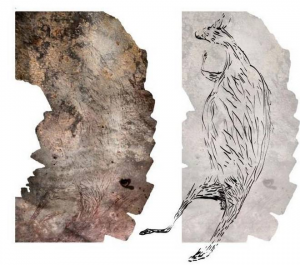Australia’s oldest rock art
Why in News?
- A kangaroo painting created over 17,000 years ago by Aboriginal artists has been identified as Australia’s oldest intact rock art.
Aborigines
- Aboriginal culture dates back as far as between 60,000 to 80,000 years. This is when Aborigine’s first settled in Australia. The first evidence of Aboriginal ethos or philosophy is evident in the still visible rock art which dates back more than 20,000 years.
- Ochres were used to paint on rocks. Archaeologists have been able to date remains and findings as far back as 40,000 to 60,000 years from discoveries of primal campsites.
About the discovery

- The two-metre-long (six-feet) artwork on the sloped ceiling of a rock shelter in Western Australia’s Kimberley region was painted in an early naturalistic style, which often features life-sized renderings of animals
- The researchers estimated that the kangaroo painting was between 17,500 and 17,100 years old, the oldest discovered to date in Australia.
- The images were mostly depictions of animals, including a snake, a lizard-like figure, and three macropods — marsupials including kangaroos, wallabies and quokkas.
Rock arts of India
- The petroglyph rock art at Daraki-Chattan (hillock) near Bhanpura in Mandsaur district (Madhya Pradesh) is the “world’s oldest rock art” and is almost 2 to 5 lakh years’ old.
- A petroglyph is an image created by removing part of a rock surface by incising, picking, carving, or abrading, as a form of rock art.
Other works
- Earliest rock paintings in India are from the Upper Palaeolithic Age.
- Rock paintings have been found in the walls of caves at Madhya Pradesh, Andhra Pradesh, Uttar Pradesh, Bihar and Karnataka, some in the Kumaon Hills of Uttarakhand.
- 3 categories of paintings have been found- man, animal and geometric patterns in black, white and red ochre.
- Humans are represented in stick-like forms. A long-snouted animal, a fox and a multiple legged lizard are the main animal motifs. Wavy lines, rectangle-filled geometric designs, and groups of dots can also be seen here
- There is some superimposition of paintings. The earliest are in black; over these are red ochre paintings and the last group comprises white paintings.
Paintings in Kupgallu (Telangana), Piklihal (Karnataka) and Tekkalkota (Karnataka)
- Mostly in white and red ochre.
- Subjects are bulls, sambhars, elephants, sheep, gazelles, goats, horses, stylised humans and tridents.
Paintings in the Vindhya ranges at Madhya Pradesh extending into Uttar Pradesh –
- About 500 rock shelters at Bhimbetka in the Vindhya Hills at Madhya Pradesh.
- Images of hunting, dancing, music, elephant and horse riders, honey collection, animal fighting, decoration of bodies, household scenes, etc.
Periods of Bhimbetka drawings
- Period I: Upper Palaeolithic
- Period II: Mesolithic
- Period III: Chalcolithic
- Two major sites of prehistoric rock/cave paintings in India: Bhimbetka Caves and Jogimara Caves (Amarnath, Madhya Pradesh).
Bhimbetka Paintings
- Continuous occupation of these caves from 100000 BC to 1000 AD.
Period I (Upper Palaeolithic)
- Linear representations of animals like bison, tigers, elephants, rhinos and boars; stick-like human figures.
- Paintings in green and dark red. Green paintings are of dancers and red ones are of hunters.
Period II (Mesolithic)
- The largest number of paintings are found in this period.
- More themes can be found but paintings reduce in size.
- Mostly hunting scenes – people hunting in groups with barbed spears, arrows and bows, and pointed sticks. Also, show traps and snares to catch animals.
- Hunters wear simple clothes; some men are shown with headdresses and masks. Women have been shown both clothed and in the nude.
- Animals seen – elephants, bisons, bears, tigers, deer, antelopes, leopards, panthers, rhinos, frogs, lizards, fish, squirrels and birds.
- Children are seen playing and jumping. Some scenes depict family life.
Period III (Chalcolithic)
- Paintings indicate an association of these cave-dwellers with the agricultural communities settled at Malwa.
- Cross-hatched squares, lattices, pottery and metal tools are depicted.
- Colours used in Bhimbetka paintings – white, yellow, orange, red ochre, purple, brown, green and black. Most common colours – white and red.
- Red obtained from haematite, green from chalcedony; white probably from limestone.
- Brushes were made from plant fibre.
- In some places, there are many layers of paintings, sometimes 20.
- Paintings can be seen in caves that were used as dwelling places and also in caves that had some other purpose, perhaps religious.
- The colours of the paintings have remained intact thousands of years perhaps due to the chemical reaction of the oxide present on the rock surface.
Reference:
Subscribe
Login
0 Comments
